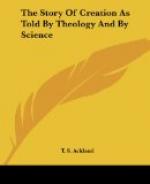But next, we have not to do with one series of changes only, but with a vast number of different series going on in different directions, if we are to have a large variety of animals produced from a common stock. All the probabilities against the separate variations must be combined, not by addition, but by multiplication, so that the probabilities against the production of all these separate forms become enormous.
Against all this improbability Mr. Darwin brings forward the supposed advantages which these variations give to their possessors. But here again a new element is introduced into the calculation. It is assumed, in the very statement of the question, that the process of adaptation has already taken place; the original stock must have been adapted to the circumstances under which they existed, or in their case the whole theory fails. If, then, a fresh adaptation is wanted, it must be because a change in external circumstances must have taken place. In order that a new variety may be established there must be a concurrence between the change of external circumstances and the change in the animals. Here we get a new, and a large factor for our multiplication.
This argument may be, perhaps, made clearer by an illustration. Mr. Darwin has written a very interesting book on the fertilization of orchids by means of insects. According to his view all insects are descended from one common type, and all orchids are also descended from one parent; but we meet with insects and orchids in pairs, each perfectly adapted to the other. We will suppose that a change takes place in a particular orchid, that the nectary recedes to a greater distance from the point to which the insect can penetrate, and so an advantage is given to those insects in which the haustellum is of a length above the average. This may have a slight tendency to increase the number of such insects; but then it will have an opposite tendency in the case of the orchid. It cannot, of course, be supposed that the variation, which is only partial in the insect, is universal in the plant. The unchanged insects will therefore be confined to the unchanged flowers, while the changed insects will be indifferent on the subject, as they will be able to reach the nectary in any case. Hence, an advantage will be given to the unchanged flower, which will be more likely to be fertilized, and the two lines of variation will move in opposite directions.




